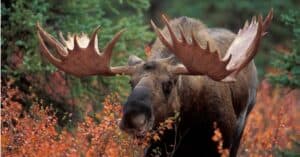Australia has the largest concentration of animals with pouches. There are 330 species of animals with pouches that live in Australia. South America also has a large population of animals with pouches. These animals are called marsupials.
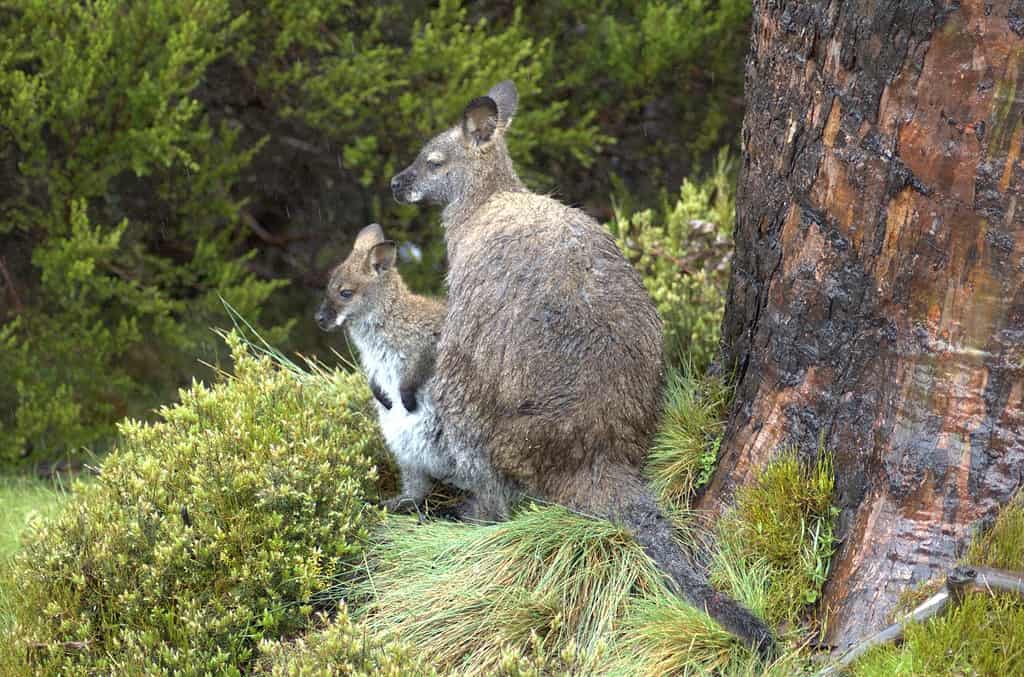
A mother wallaby carries her young in a pouch for eight months after birth.
Marsupials
Marsupials are mammals that give birth to underdeveloped young. The newborn marsupial climbs into the mother’s pouch until it completely develops. This process takes many months to complete.
Marsupials have teats inside their pouches, and the babies suckle at the teat and drink rich mother milk during their developmental phase. Most mammal infants suckle at the teat until it is complete, then release it until they grow hungry again. A marsupial infant latches onto the teat when it enters the pouch, and they keep the nipple in their mouth until they have developed more. The nipple swells, and the infant cannot let go of it until it has grown more.

A koala is a marsupial and carries their young in a pouch until they are fully developed.
©Constantin Stanciu/Shutterstock.com
Marsupials are unique and interesting animals. However, they are also quickly disappearing. Many marsupial species are now extinct.
Diprotodontia
There are seven orders of marsupials, and the diprotodontia is the most significant order. Diprotodontia marsupials are syndactylous. That means that on their hind feet, the second and third digits are fused. Also, they are diprotodonts. That means they have a single pair of incisors dominant on their lower jaw section. However, there are diprodontia marsupials that have an additional pair of incisors present. They do not have canine teeth.
There are ten families of Diprodontia marsupials and 117 species. Quokka, koalas, wombats, and sugar gliders are in the order Diprotodontia.
1. Koalas

A koala is pregnant for 30 to 36 days and then carries the baby in her pouch for six additional months.
©rickyd/Shutterstock.com
The koalas are marsupials that are pregnant for 30 to 36 days and then carry the baby in their pouch for six months. Subsequently, the joey (koala baby) will climb out of the pouch and ride on its mother’s back for a year before venturing independently.
Koalas move very slowly, and although they are called koala bears, they are not bears. They eat eucalyptus leaves, which are poisonous to most other animals. The animals are nocturnal, which helps them survive in their dry climate.
Koalas get most of their liquids from the leaves of the eucalyptus; however, during droughts, they do need water. These marsupials live for 10 to 12 years in the wild. However, they live up to 18 years in zoos, receiving proper care and nutrition. In the wild, dingos and wedge-tailed eagles are the most significant predators of the koala.
2. Kangaroos
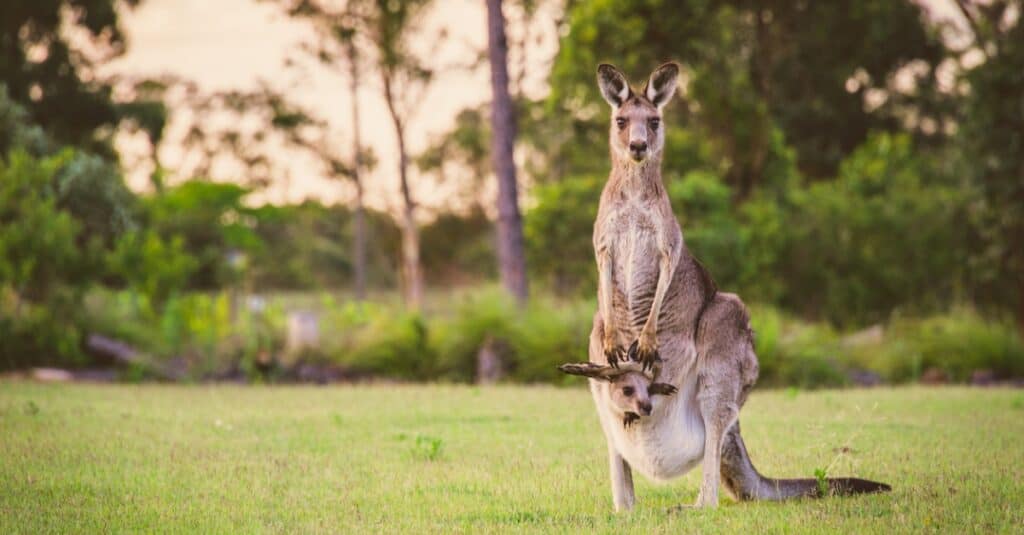
Kangaroos are the most recognized marsupials in Australia.
©iStock.com/Andrew Coleman
There are sixty species of kangaroos. They are the largest marsupials, and the red kangaroo is more giant than the others. Kangaroos can reach heights of eight feet. Females carry their joeys for 28 to 36 days. At birth, the joey will be the size of a jelly bean. After being born, the joey will remain in the female’s pouch for an additional eight months while it develops.
If food is scarce during the pregnancy, the female can pause the embryo’s development until the conditions are right for it to continue. This process is called embryonic diapause. Another reason a female might pause the pregnancy is if they have a joey still in their pouch.
In the wild, kangaroos live for about eight years. However, kangaroos in zoos can live up to 25 years with the proper diet and care. The common predators of kangaroos are dingos, humans, and wedge-tailed eagles.
3. American Opossums
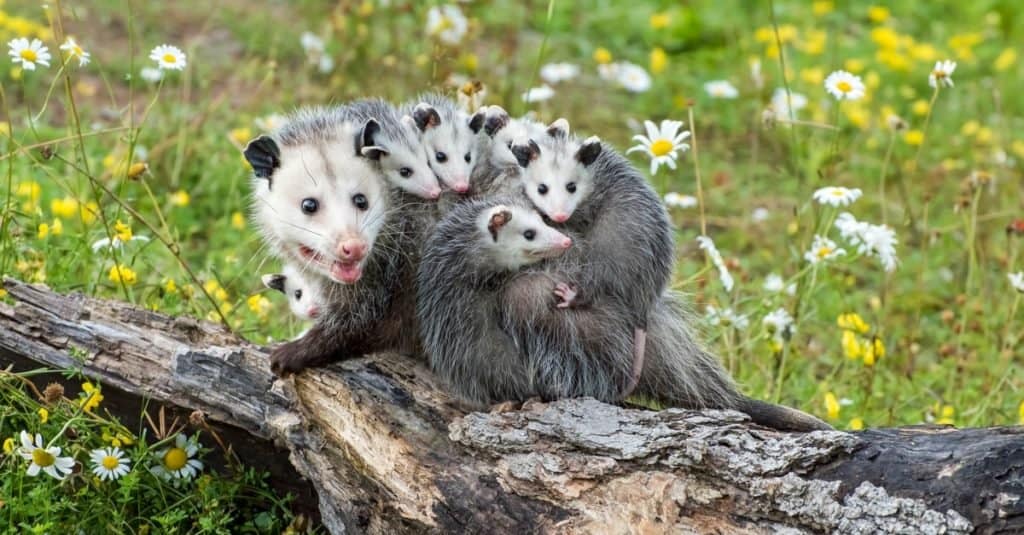
Opossums may have up to 20 babies at one time.
©Evelyn D. Harrison/Shutterstock.com
American opossums give birth after being pregnant for 11 to 13 days. The normal litter has five to eight babies; however, a litter as large as 20 is possible. The newborn opossums are so tiny that you could fit as many as twenty in a teaspoon. The mother’s teat swells in the mouths of the young, and for the next two months, they will remain latched on. The mother opossum only has 13 teats, and not all will be functional.
When the babies are three months old, the mother weans them, and they leave the pouch. After leaving the pouch, they travel with the mother by clinging to her back. The babies will stay with their mom for about one year.
Opossums live between two and four years. The most common predators of the opossum are dogs, foxes, bobcats, great-horned owls, humans, and large hawks. One opossum eats up to 5,500 tick larvae each week.
4. Sugar Gliders
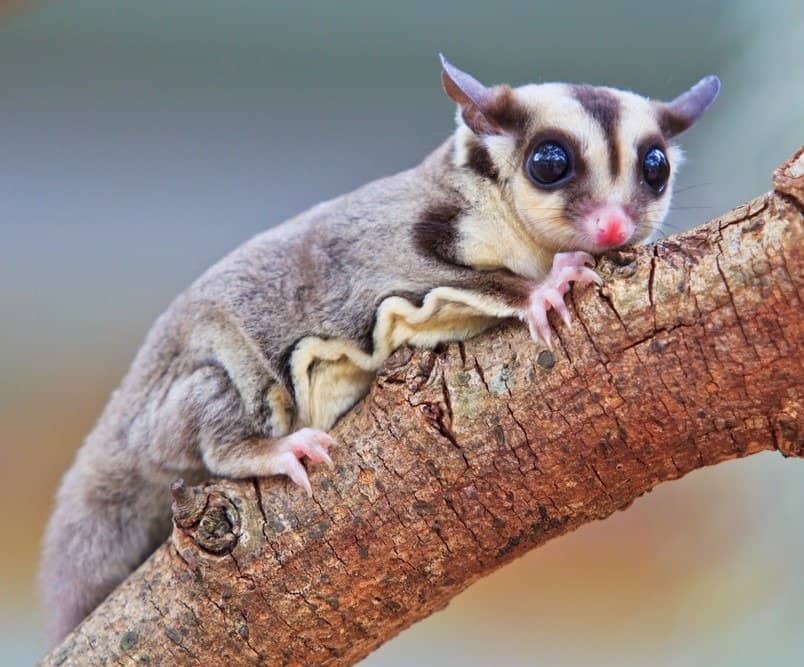
Sugar gliders are Australian marsupials.
©apiguide/Shutterstock.com
A common name for sugar gliders is the flying squirrel. They are native to Australia, and they are animals with pouches. The sugar glider gestation period is between 15 and 17 days. The mother gives birth to two babies. After birth, the baby animals stay in the mother’s pouch for 70 to 74 days. They give birth about twice a year.
Their natural predators include owls, kookaburras, cats, and goannas. The sugar glider has a lifespan of 12 to 15 years. These animals are nocturnal and are called sugar gliders because they prefer sweet foods. In times of stress, they can slow their breathing and reduce their body temperature. This is called torpor. The animals can remain in this state for weeks.
5. Wallaby

Like kangaroos, the wallabies carry their young in their marsupium until they fully develop.
©Shmenny50/ via Getty Images
A wallaby is a marsupial native to Australia and New Guinea. The female gestates for 29 to 35 days, and when the joey is born, it will live in the marsupium, or pouch of the mother, for about eight months. The swamp wallaby is the only animal with a pouch that is always pregnant.
The swamp wallaby will have a joey in her pouch, and they will have two embryos at different stages of development inside them. The wallaby is unique and has two uteri. This allows them to have a beginning embryo and a later-stage embryo simultaneously. Like kangaroos, they can pause embryonic development until the perfect time for the joey to finish developing.
In the wild, these animals live for up to 15 years. You will not find a wallaby or kangaroo living in the same area. They prefer different environments. The natural predators of the wallaby are dingos, wedge-tail eagles, and Tasmanian devils. However, feral predators such as cats, dogs, and foxes have been introduced into their environment.
6. Echidna

Echidnas are egg-laying mammals with a pouch.
©Jarrod Calati / via Getty Images
The echidna is a unique animal with a pouch. Most animals with a pouch give birth to live young, but the echidna lays a leathery egg. The mother moves the egg into her pouch. It takes ten days for the egg to hatch, and then the baby stays in the pouch for about seven weeks. At birth, the “puggle” will be the size of a raisin. When it emerges from the protective pouch, it will have started to grow the spines on its back and sides.
After the puggle emerges from the pouch, the mother will keep it in a burrow until it is between seven and eight months old. The lifespan of these animals is between 30 and 40 years. Predators of the echidnas include dingos, goannas, snakes, and cats.
The only mammal other than the echidna that lays eggs is the platypus. The animals do not have teeth. They eat a lot of ants, worms, termites, and insect larvae. One echidna can eat as many as 40,000 ants in a day.
7. Wombat
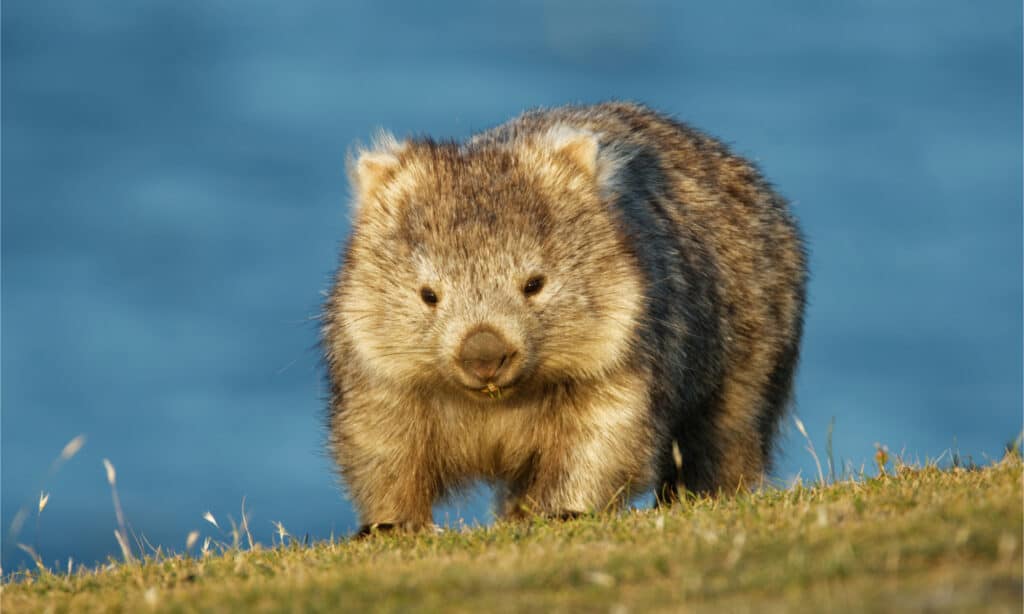
A wombat is a marsupial from Australia.
©Martin Pelanek/Shutterstock.com
A wombat female will give birth to one joey every two years. The gestation period of the wombat is 21 to 30 days. The joey will be the size of a jelly bean at birth. The baby wombat will reside in the pouch for about six months. When they first emerge from the safety of the pouch, they will come out for short periods and then go back inside. This behavior continued for about two months.
Wombats have a lifespan of about 15 years, although, in captivity, with proper nutrition, they live to be about 20. Predators such as dingos, foxes, and wild dogs are the main reason for premature wombat deaths.
8. Sea Otters
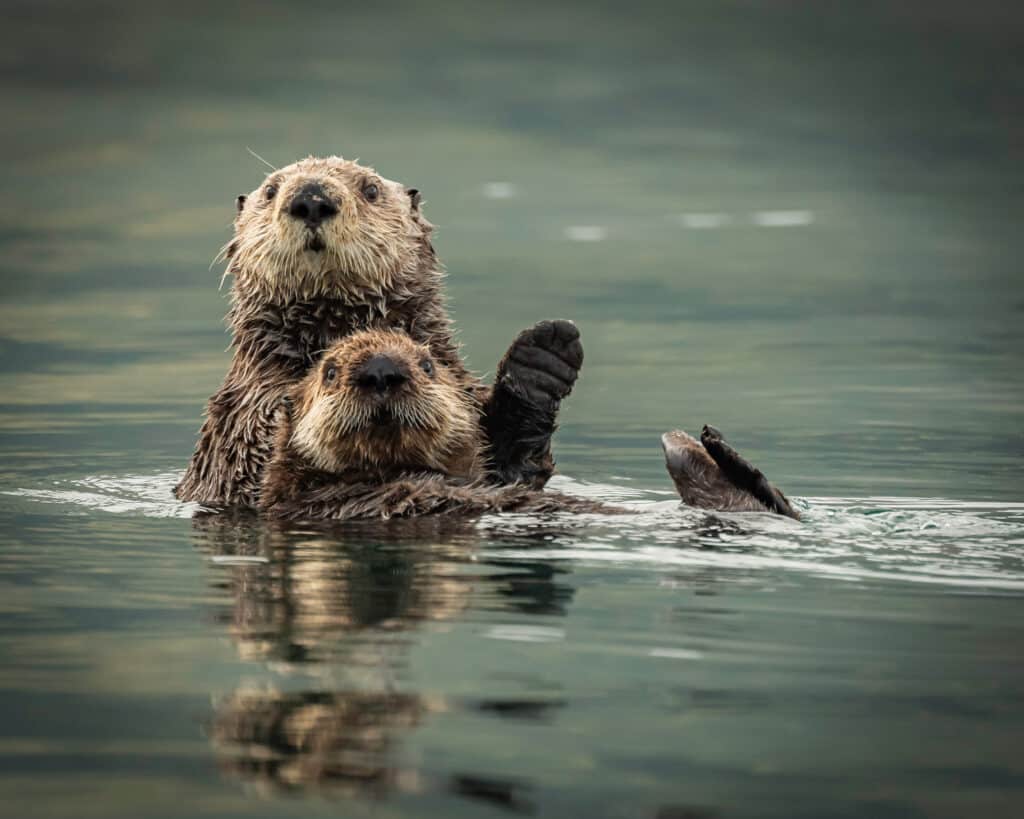
Sea Otters use their pouches to carry things in.
©Laura Hedien/Shutterstock.com
The pouch of a sea otter is a fold of skin positioned on the chest under the forearms. Instead of carrying their young in the pouch like the marsupials do, the sea otter uses its pockets or pouches to store favorite rocks and items they wish to keep.
Sea otters have lifespans of 10 to 20 years. The females live up to five years longer than the males. Their natural predators include bald eagles, brown bears, wolves, killer whales, and great white sharks.
9. Dasyurids or Tasmanian Devils
Dasyurids are better known as Tasmanian devils. Tasmanian devils are marsupials from Australia. These animals with pouches have a gestation period of 21 days. At the time of their birth, the babies are the size of a grain of rice. The mother will give birth to as many as 30 babies simultaneously, although she only has four teats to feed the young. Sadly, only four of the young will survive to live in the marsupium for about four months.,
After leaving the pouch, the young dasyurids will live in a den or a hollow log for another two to three months. Tasmanian devils have lifespans of about five years. They live up to eight years in captivity, protected from disease, famine, and predators. Tasmanian devil predators include dogs, foxes, humans, and the Tasmanina wedge-tail eagle.
10. Bandicoots
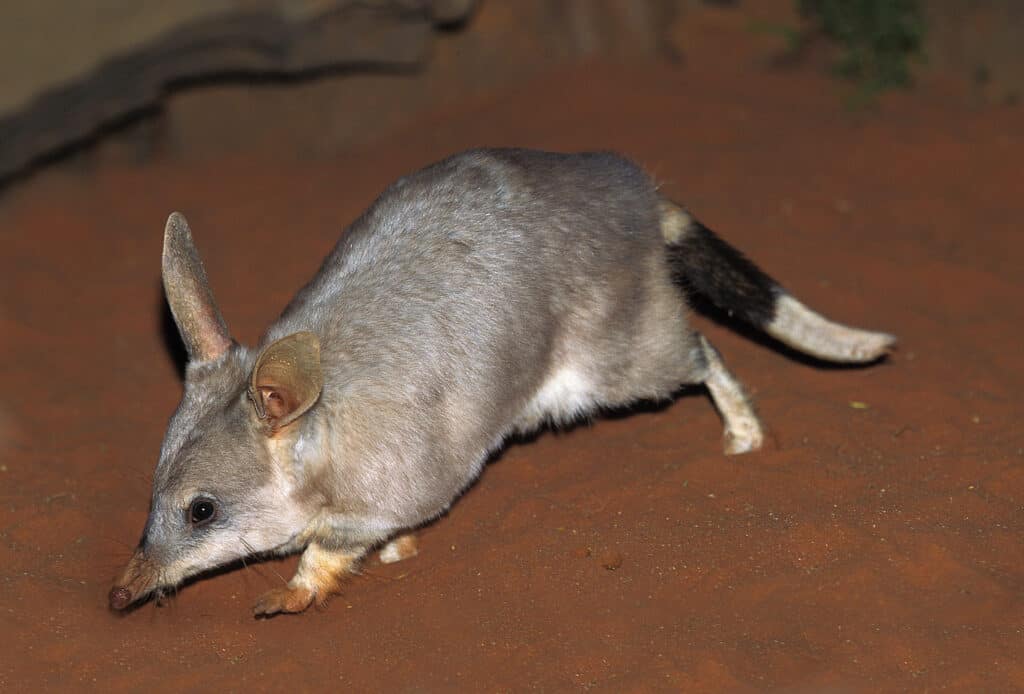
Bilbies have long ears and snouts and are marsupials from Australia.
©iStock.com/slowmotiongli
The bandicoot is commonly called a Bilby in Australia. These marsupials have gestation periods of 11 to 12 days when they will give birth to up to five young. Only one or two of the babies will survive. The mother carries them in her pouch for 50 to 60 days. When the young bandicoot leaves the pouch, it is grown and does not stay with its mother.
Bandicoots can have several litters each year. These animals with pouches live for two to four years. The predators of the bandicoot include owls, quolls, and dingos. Bandicoots are solitary animals that dig burrows to live in.
12. Quoll

A quoll is an Australian marsupial.
©Craig Dingle/Shutterstock.com
The list of animals with pouches includes the quoll from Australia. The gestation period for quoll is 18 to 21 days. When they are born, the babies are the size of rice grains. The mother will have a litter of up to 30 pups, but she will only be able to feed up to six or eight pups. Pups stay in their mother’s pouch for nine weeks.
A quoll is small, but they have a vicious bite. A Tasmanian devil is the only animal said to have a stronger bite than a quoll. These animals with pouches live for up to four years. Their most common predators are foxes and feral cats.
13. Tree-Kangaroo
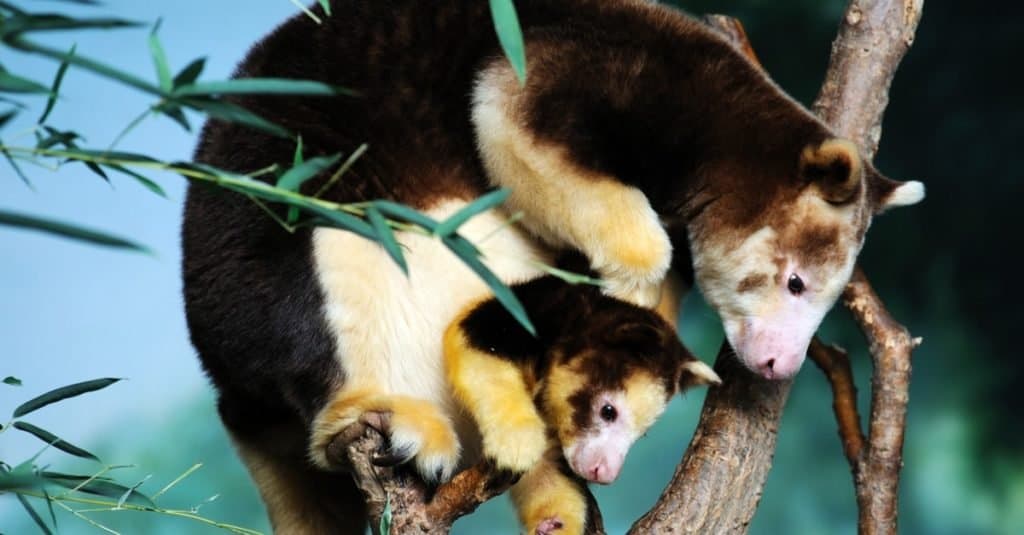
Tree Kangaroos are marsupials found in Australia and New Guinea.
©Michael Jacob Photography/Shutterstock.com
The tree kangaroo is a macropod-like ground-dwelling kangaroo and wallaby. There are some distinct differences, though. How these animals with pouches can move their hind legs independently differs from ground-dwelling kangaroos.
The tree dwellers have babies called joeys, and like ground-dwelling kangaroos, they carry the joey in their pouch for up to 10 months. The lifespan of the tree kangaroo is 15 to 20 years. The predators of these animals include dogs, cats, snakes, dingos, and humans.
14. Sea Horses
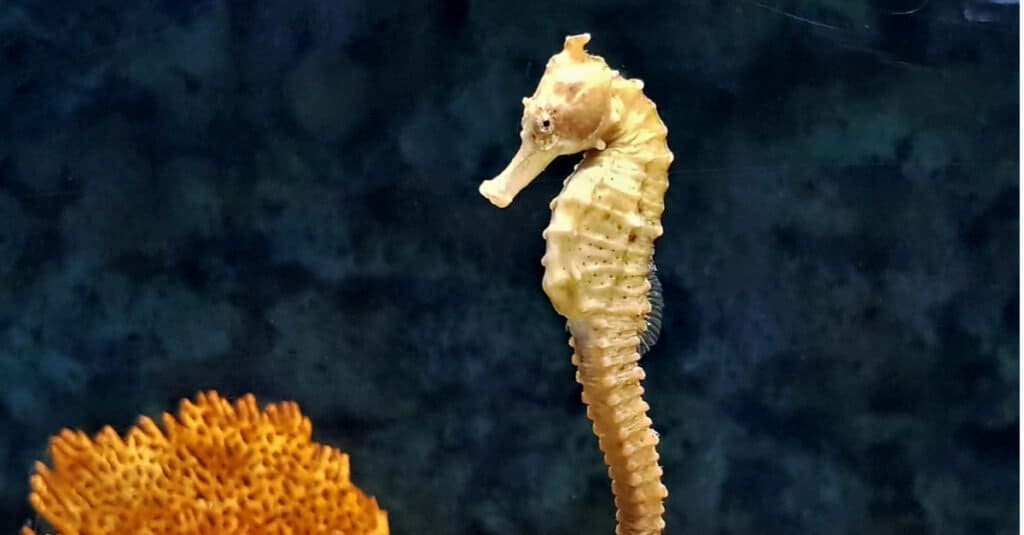
Male seahorses are animals with pouches.
©Arunee Rodloy/Shutterstock.com
When you think of animals with pouches, you do not always think of seahorses. Sea horses are different from most animals because the male sea horse is the one that gives birth and carries the young in a pouch. The female sea horse inserts her eggs into the pouch on the rear of the male sea horse. The pouch works like a uterus and incubates the eggs for up to ten weeks until they hatch.
Sea horses remain monogamous during breeding, but the pairs may reproduce several times each season. When the young sea horses leave the pouch, they are grown and do not remain around their parents.
15. Musky Rat Kangaroo
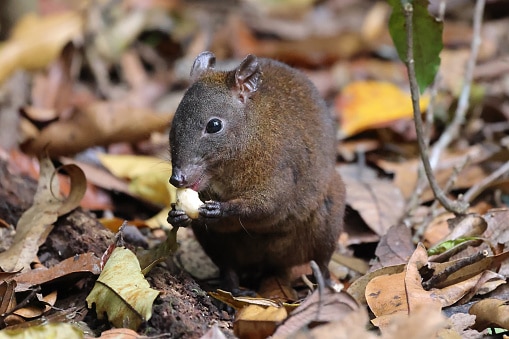
The musky rat kangaroo is a small marsupial from Australia.
©Ken Griffiths/iStock via Getty Images
The list of animals with pouches includes several kangaroo species. The musky rat kangaroo is the smallest in Australia. They are marsupials, carrying their young in a pouch for 21 weeks, a shorter time than more giant kangaroos.
These kangaroos are active during the day instead of at night. They grow to an adult weight of 1.5 pounds and have lifespans of up to four years. Their diet consists of worms, roots, and palm berries. They help the ecosystem by spreading the seeds to new areas.
16. Common Brushtail Opossum
Brushtail opossums live in Australia. These animals with pouches have a gestation period of 18 days. When the tiny opossum baby moves into the mother’s pouch, they latch onto a teat and remain there for four to five months. For the next two months the little opossum will go in and out of the pouch and spend time hanging onto the back of its mother, much like the American opossum babies do.
These animals eat leaves, buds, fruits and flowers. They have a lifespan of up to 12 years. The common predators of the brushtail opossum are dingos, pythons, cats and foxes.
20. Quokkas
The happiest marsupial on earth is the naturally smiling quokka. The quokka is an Australian marsupial that is kin to the kangaroos. These small creatures have front facing pouches like kangaroos and their offspring are called joeys. The quokkas carry their joeys in the pouch for about six months.
The appearance of a smile on the faces of these animals with pouches is why they are called the happiest animals in the world. These kangaroo cousins can only be found on Rottnest and Baldnest islands in Australia.
They have a lifespan of 10 to 15 years and each female can have two pregnancies per year. There will only be one joey born at a time, and on Rottnest island the breeding season is shorter than on Baldnest island so the females usually have one pregnancy per year.
22. Flipper Wearing Yapok
The aquatic flipper-wearing yapok is called a water possum. These aquatic animals with pouches live in Mexico, and Central and South America. The little animals can carry between two and five joeys in their pouches at one time. Joeys grow rapidly and are independent within 45 days.
They are nocturnal animals that prefer the solitary lifestyle. Yapok eat fish, frogs, and small reptiles and aquatic animals. They burrow into the sides of the banks surrounding the waterway they are at. They cannot live in polluted water.
Summary of Animals The Complete List of Animals With Pouches
| Animal | Country of Origin | |
|---|---|---|
| 1 | Koalas | Australia |
| 2 | Kangaroos | Australia |
| 3 | American Opossum | South America |
| 4 | Sugar Gliders | Australia |
| 5 | Wallaby | Australia and New Guinea |
| 6 | Echidna | Australia and New Guinea |
| 7 | Wombat | Australia |
| 8 | Sea Otter | U.S., Russia, and Japan. |
| 9 | Dasyurids | Australia |
| 10 | Bandicoots | Australia |
| 11 | Quoll | Australia |
| 12 | Tree Kangaroo | Australia and New Guinea |
| 13 | Sea Horses | Almost worldwide |
| 14 | Musky-Rat Kangaroo | Northeastern Australia |
| 15 | Brushtail Opossum | Australia |
| 16 | Quokkas | Rottnest and Baldnest Islands Australia |
| 17 | Flipper Wearing Yapok | North America and South America |
Thank you for reading! Have some feedback for us? Contact the AZ Animals editorial team.






